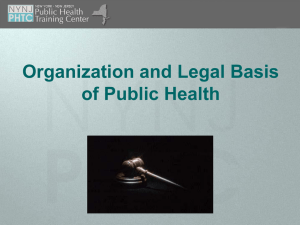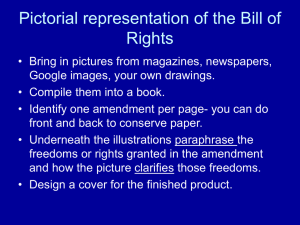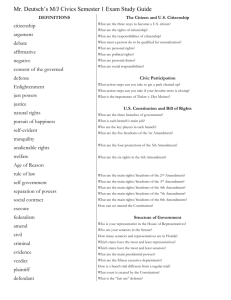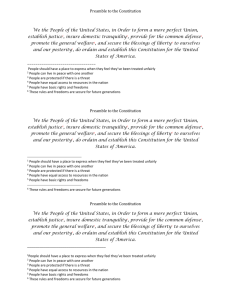American Freedoms: First Amendment Supreme Court Cases
advertisement
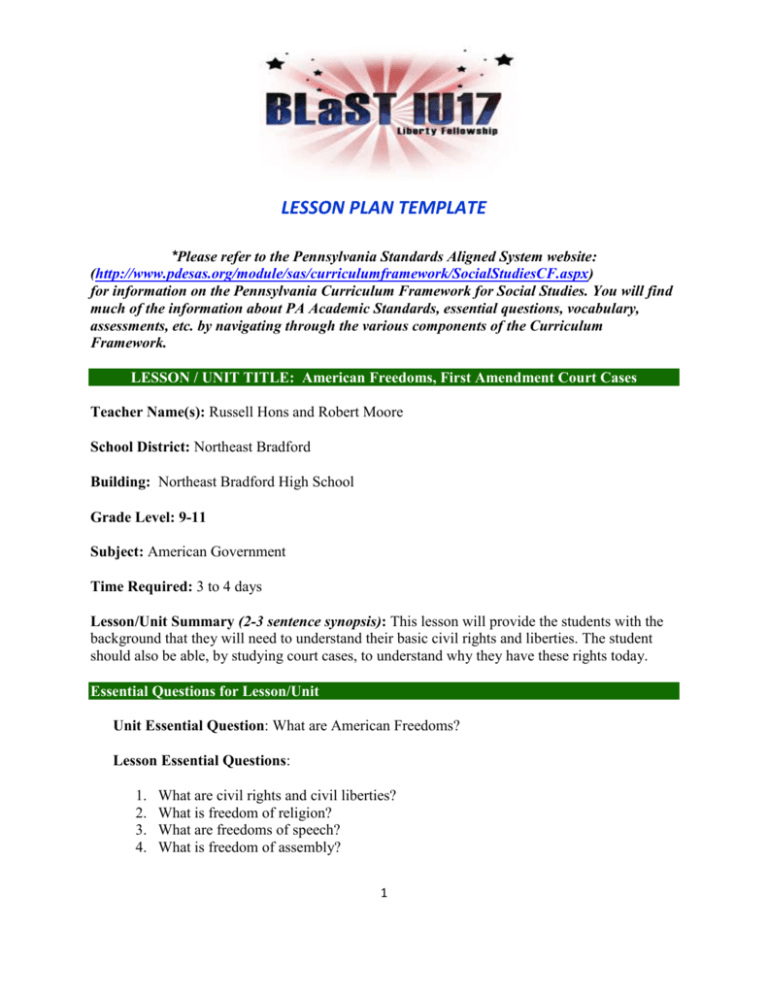
LESSON PLAN TEMPLATE *Please refer to the Pennsylvania Standards Aligned System website: (http://www.pdesas.org/module/sas/curriculumframework/SocialStudiesCF.aspx) for information on the Pennsylvania Curriculum Framework for Social Studies. You will find much of the information about PA Academic Standards, essential questions, vocabulary, assessments, etc. by navigating through the various components of the Curriculum Framework. LESSON / UNIT TITLE: American Freedoms, First Amendment Court Cases Teacher Name(s): Russell Hons and Robert Moore School District: Northeast Bradford Building: Northeast Bradford High School Grade Level: 9-11 Subject: American Government Time Required: 3 to 4 days Lesson/Unit Summary (2-3 sentence synopsis): This lesson will provide the students with the background that they will need to understand their basic civil rights and liberties. The student should also be able, by studying court cases, to understand why they have these rights today. Essential Questions for Lesson/Unit Unit Essential Question: What are American Freedoms? Lesson Essential Questions: 1. 2. 3. 4. What are civil rights and civil liberties? What is freedom of religion? What are freedoms of speech? What is freedom of assembly? 1 LESSON PLAN TEMPLATE Pennsylvania Academic Standards Addressed in Lesson/Unit 5.1.12. B. Analyze the sources, purposes, functions of law, and how the rule of law protects individual rights and promotes the common good. 5.1.12. C. Evaluate the application of the principles and ideals in contemporary civic life. 5.1.12. F. Analyze and assess the rights of people as written in the Pa Constitution and the U.S. Constitution 5.2.12. G. Evaluate and demonstrate what makes competent and responsible citizens 5.1.12. L. Analyze United States court decisions that have affected principles and ideals of government in civic life. 5.3.12. B. Analyze the powers and responsibilities of the national government; analyze the role of the Supreme Court in interpreting the U.S. Constitution. 5.3.12. G. Evaluate how the government protects or curtails individual rights and analyze the impact of supporting or opposing those rights. Lesson/Unit Objectives Students should be able to understand: 1. Evolution of civil and human rights 2. Role the government plays in protecting human rights 3. Civil rights and civil liberties in the United States 4. Responsibilities of American citizenship 2 LESSON PLAN TEMPLATE Vocabulary/Key Terms for Lesson/Unit civil liberties secular pure speech speech plus symbolic speech libel slander actual malice treason press prior restraint Historical Background for Teachers / Research Narrative American Freedoms When the Constitution was written, the founding fathers included Article III. This Article briefly described the role of the Supreme Court. With the addition of the Bill of Rights, the First Amendment has brought many cases to be viewed by the Court. Since there have been many challenges to these two Amendments, the court has had to settle issues to define our rights. Remember the court doesn’t look for cases; the cases are brought to them. In this Unit lesson, we will be looking at many court cases that have defined our freedoms. These include, Lemon vs. Kurtzman, Near vs. Minnesota, Wisconsin vs. Yoder, Richmond Newspaper vs. Virginia, and Feiner vs. New York. 3 LESSON PLAN TEMPLATE In searching for documents to show how our freedoms have evolved, we come to understand why it is important to have a court system to interpret our amendment rights for us. Without these protections where would we be? It is important to remember in our lessons to convey these ideas to our students. It is also important engage them in debate to show the power of Democracy and the freedoms they possess. Instructional Prodedures and Activities Note: The order of the lessons and the number of Lesson Essential Questions (LEQs) you plan per day may shorten or lengthen your lesson time. Lesson 1 1. Distribute Student Learning Map to students a. Review Unit Essential Questions (UEQ). b. Discuss Lesson Essential Questions (LEQ) 2. Activating strategy: This could be a court case or situation activity on and American Freedom. 3. Begin Power point presentation on American Freedoms: a. Review history of Bill of Rights and 14th Amendment to the U.S. Constitution. b. Discuss civil rights and civil liberties c. Define and provide examples of Freedom of Religion 4. Post Vocabulary List on Word Wall. 5. Assign court cases to read for discussion: Freedom of Religion 4 LESSON PLAN TEMPLATE Lesson 2 1. Discuss Lesson Essential Questions (LEQ) 2. Discuss court case readings on Freedom of Religion 3. Continue Power Point Presentation: Freedom of Speech and Press 4. Post new vocabulary on Word Wall 5. Assign court case readings: Freedom of Speech and Press Lesson 3 1. Discuss Lesson Essential Questions (LEQ) 2. Activating strategy: Get students involved with an activity about court facts or case that involve student rights 3. Organize students in collaborative pairs to discuss court cases on freedom of Speech and Press, followed by class discussion on student rights and responsibilities 4. Continue Power Point Presentation: Freedom of Assembly 5. Post new vocabulary on Word Wall 6. Assign court case readings: Freedom of Assembly and Petition 5 LESSON PLAN TEMPLATE Lesson 4 1. Review LEQ and discuss court cases on Freedom of Assembly 2. Post new vocabulary on Word Wall 3. Review Unit and Lesson essential Questions 4. Optional Assignment. Essay on American Freedoms: Which First amendment Freedom is most important to you as a student and why? Use Specific Supreme court cases to justify your position. Suggested Strategies for Differentiating Instruction 1. Follow student IEP provisions 2. Use student learning map to individualize instructional activities 3. Provide copy of notes 4. Use graphic organizers and study guides to help students organize information 6 LESSON PLAN TEMPLATE Assessment of Student Learning (Formative and Summative) Formative: 1. 2. 3. 4. Section review question Evaluation of notes Teacher observation Evaluation of handouts Summative: 1. Unit exam 2. Final exam 3. Assessment of Essay on American Freedoms Materials and Resources 1. Handouts of court cases with notes sheet. Use handouts of the court cases with a notes section included on the sheet. You can use whatever cases you want when instructing the students. We usually select ones that relevant to them, such as student rights cases. 2. The court cases are researched on the Internet and displayed on an overhead projector or white board. 3. Optional Skokie Movie to show in class. (Skokie versus the NAZIs case) Author(s) of Unit/Lesson Plan Russell Hons and Robert Moore, Northeast Bradford School District, Northeast Bradford High School 7 LESSON PLAN TEMPLATE 8
